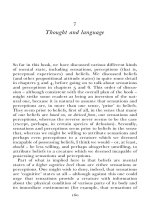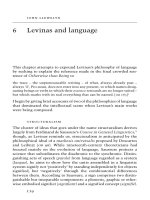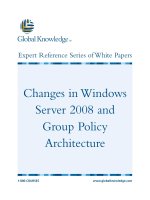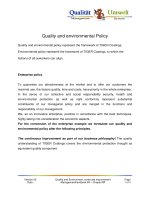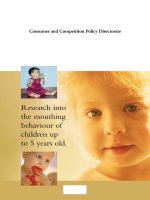ethnography and language policy
Bạn đang xem bản rút gọn của tài liệu. Xem và tải ngay bản đầy đủ của tài liệu tại đây (10.58 MB, 328 trang )
Ethnography and Language Policy
“This book brings together some of the best scholars in the field to rebuild the connection
between anthropology and linguistics that produced sociolinguistics, firmly establishing the
relevance of an ethnographic and policy approach to education. . . . It will quickly become
the standard course text.”
Bernard Spolsky, Bar-Ilan University, Israel
Illuminating, through ethnographic inquiry, how individual agents “make” language
policy in everyday social practice, this volume advances the growing field of language
planning and policy using a critical sociocultural approach. From this perspective, language policy is conceptualized not only as official acts and documents, but also as
language-regulating modes of human interaction, negotiation, and production mediated
by relations of power.
Using this conceptual framework, the volume addresses the impacts of globalization,
diaspora, and transmigration on language practices and policies; language endangerment,
revitalization, and maintenance; medium-of-instruction policies; literacy and biliteracy
policies and practices; language and ethnic/national identity; and the ethical tensions in
conducting critical ethnographic language policy research. These issues are contextualized
in case studies and reflective commentaries by leading scholars in the field.
Extending previous work in the field, tapping into leading-edge interdisciplinary scholarship, and charting new directions, Ethnography and Language Policy:
•
•
•
•
Joinslanguagepolicyresearchwithethnographicmethodsandanalysis
Takes a critical sociocultural approach to exploring how policy is enacted in social
practice
Isdeeplylocalandbroadlycomparative,probingcasesindepthwhileofferingparallels
and contrasts from the Americas, Europe, Africa, the Pacific, and South-Central Asia
Exemplifies an ethnography for social justice allied with the interests of the communities with whom researchers work
Recognizing that language policy is not merely or even primarily about language per se,
but rather about power relations that structure social-linguistic hierarchies, the authors
seektoexpandpolicydiscoursesinwaysthatfostersocialjusticeforall.
Teresa L. McCarty is the Alice Wiley Snell Professor of Education Policy Studies, Professor
of Applied Linguistics, and Co-Director of the Center for Indian Education at Arizona
State University.
This page intentionally left blank
Ethnography and Language Policy
Edited by
Teresa L. McCarty
First published 2011
by Routledge
270 Madison Avenue, New York, NY 10016
Simultaneously published in the UK
by Routledge
2 Park Square, Milton Park, Abingdon, Oxon OX14 4RN
Routledge is an imprint of the Taylor & Francis Group, an informa business
© 2011 Taylor & Francis
The right of the editor to be identified as the author of the editorial
material, and of the authors for their individual chapters, has been asserted
in accordance with sections 77 and 78 of the Copyright, Designs and
Patents Act 1988.
Typeset in Minion by Wearset Ltd, Boldon, Tyne and Wear
All rights reserved. No part of this book may be reprinted or reproduced or
utilized in any form or by any electronic, mechanical, or other means, now
known or hereafter invented, including photocopying and recording, or in
any information storage or retrieval system, without permission in writing
from the publishers.
Trademark Notice: Product or corporate names may be trademarks or
registered trademarks, and are used only for identification and explanation
without intent to infringe.
Library of Congress Cataloging in Publication Data
Ethnography and language policy/edited by Teresa L. McCarty.
p. cm.
Includes index.
1. Language policy. 2. Ethnography. 3. Anthropological linguistics. 4.
Sociolinguistics. I. McCarty, T. L.
P119.3.E87 2011
306.44'9–dc22
2010024480
ISBN13: 978-0-415-80139-3 (hbk)
ISBN13: 978-0-415-80140-9 (pbk)
ISBN13: 978-0-203-83606-4 (ebk)
This page intentionally left blank
Dedication
To the memory of Dell Hymes, seminal critical ethnographer of language in use
And to teachers of language policy in praxis –
JoshuaandGellaFishman
KennethandYettaGoodman
Wayne Holm
Dónall Ó Riagáin
Bernard Spolsky
Tove Skutnabb-Kangas
Contents
Foreword
COURTNEY CAzDEN
x
Preface
xii
Acknowledgments
xiv
ENTRY INTO CONVERSATION
Introducing Ethnography and Language Policy
1
TERESA L. McCARTY
ETHNOGRAPHY AND LANGUAGE POLICY CASES AND
CONTEXTS, PART I
1 Critical Ethnography and Indigenous Language Survival:
Some New Directions in Language Policy Research and
Praxis
29
31
T E R E S A L . M c C A R T Y, M A R Y E U N I C E R O M E R O - L I T T L E ,
L A R I S A WA R H O L , A N D O F E L I A z E P E D A
2 “How Are You Hopi if You Can’t Speak It?”: An
Ethnographic Study of Language as Cultural Practice
among Contemporary Hopi Youth
53
SHEILAH E. NICHOLAS
3 Diaspora Communities, Language Maintenance, and Policy
Dilemmas
77
A.SurEShCAnAGArAJAh
4 Reconstructing Ethnography and Language Policy in
Colonial Namibian Schooling: Historical Perspectives on
St Mary’s High School at Odibo
RODNEY K. HOPSON
99
viii
Contents
INTERLUDE – COMMENTARIES ON PART I
119
Language Ideologies, Ethnography, and Ethnology: New Directions
in Anthropological Approaches to Language Policy
121
PErrYGIlmorE
Language, Globalization, and the State: Issues for the New Policy
Studies
128
JAmESCollInS
ETHNOGRAPHY AND LANGUAGE POLICY CASES AND
CONTEXTS, PART II
137
5 International Migration and Quichua Language Shift in the
Ecuadorian Andes
139
KEndAllA.KInGAndmArlEEnhAb oud
6 Exploring Biliteracy in Ma-ori-Medium Education: An
Ethnographic Perspective
161
R I C H A R D H I L L A N D S T E P H E N M AY
7 US Latinos and the Learning of English: The Metonymy of
Language Policy
185
m A rY C Aro lC o m b S , n o r mA G o n z á lE z ,An d lu I S C . m o l l
8 Critical Perspectives on Language-in-Education Policy:
The Corsican Example
205
AlExAndrAJAFFE
9 Languages, Texts, and Literacy Practices: An Ethnographic
Lens on Bilingual Vocational Education in Wales
231
m A r I l Y n m A r T I n - J o n E S
10 Researching-Texting Tensions in Qualitative Research: Ethics in
and around Textual Fidelity, Selectivity, and Translations
255
VA I D E H I R A M A N A T H A N
DISCUSSION AND SYNTHESIS
271
11 The Ethnography of Language Policy
273
n A n C Y h . h o r n b E r G E r A n d d Av I d C A S S E l S J o h n S o n
Contents
ix
About the Contributors
290
Index
297
Foreword
Courtney Cazden
In the first commentary chapter for Ethnography and Language Policy,PerryGilmore
harks back to Dell Hymes, to whom this book is dedicated, and reminds readers of
an earlier book, Functions of Language in the Classroom(Cazden,John, & hymes,
1972),whichheconceptualizedinhis46-pageIntroduction.Gilmoresuggeststhatit
was “an early precursor to the present volume.” As one of Hymes’s co-editors of FoL,
I am humbled by how much simpler our research task was nearly 40 years ago.
We had a single focus on the micro level of face-to-face interaction within the
classroom community. We were responding in part to a call from President
Johnson for research recommendations for the educational component of his
War on Poverty program in the aftermath of the Civil Rights revolution. Not surprisingly in that context, two-thirds of the 14 chapters located their research in
mainland United States, not yet massively affected by economic forces of globalization, and our concerns were primarily students from long-standing minority
communities – African American and American Indian.
Ethnography and Language Policy retains the critical and democratic stance of
FoL, but its scope is immeasurably greater on all counts. The ten research chapters range the world, with only three located in the US. More significantly, each
setting is now more ethnically diverse due to the package of variables we gloss as
“globalization.” Evident in many chapters are the effects of those same globalizing
forces on the marked increase in economic insecurity and its effects, in turn, on
language planning and policy (LPP) at all levels – from the state through communities to individual students.
In the intervening 40 years, linguistic theory and methodology have also
expanded. In FoL,wewereworkingwiththehymes–Gumperzconstructofthe
“ethnography of communication,” then barely a decade old. now, as James
Collins discusses in the second commentary, the ethnography of communication,
especially appropriate at the level of face-to-face communities, has been
expanded and supplemented to meet the ethnographic tasks of these new
research conditions.
Finally, in roughly this same time period, LPP itself has grown from birth
(often attributed to Norwegian American Einar Haugen) to now meriting a
WWW listserv, as McCarty describes in her Introduction. In the final discussion
and synthesis for Ethnography and Language Policy, Nancy Hornberger and David
Johnsonplacethechaptersinthatwidercontext.
Foreword
xi
These changes do not mean that the narrower FoL concerns have disappeared
– certainly not the effects of pressures for “standard English” in the US (and
standard languages elsewhere). Consider just one current example in the
“common academic standards” developed by a US consortium of Chief State
SchoolofficersandthenationalGovernorsAssociationfunctioningasaunitof
language policy formation even if subject to voluntary adoption, which were
released in June 2010. Concerns had been expressed during their development
about the difficulties that (largely immigrant) English-language learners (ELLs)
would have in meeting the English language arts standards. As a result of pressures by ELL specialists and advocates, changes were made, and the Introduction
now includes a statement that “for students still acquiring English, ‘It is possible
to meet the standards in reading, writing, speaking, and listening without displaying native-like control of conventions and vocabulary’ ” (zehr, 2010).
The history of this modest concession on standard language requirements is
an example of what Collins considers a fundamental question for all sociolinguistic inquiry, “Who gets to define what counts as language?” Any answer should
be only the beginning of ethnographic inquiry. “Ethnographic monitoring”
(Hymes, 1980) is well suited to the task of following ethnographically “the patterns and meanings that may emerge during the course of a program” and its
implementations.
I want to end on a more uplifting note and suggest to all readers a beautiful
littlebookbyEdithGrossman,anacclaimedliterarytranslator,mostrecentlyof
Don Quixote.AccordingtoGrossmaninWhy Translation Matters (2010), in the
US and the UK “only two to three percent of books published each year are literary translations,” while in Western Europe and Latin America, the numbers are
from25to40percent.AttheendofherPreface,Grossmanremindsusoftheloss
accruing from book publishers’ implicit language policy:
[Translation] represents a concrete literary presence with the crucial capacity
to ease and make more meaningful our relationships to those with whom we
may not have had a connection before. Translation always helps us to know,
to see from a different angle, to attribute new value to what once may have
been unfamiliar. As nations and as individuals, we have a crucial need for
that kind of understanding and insight. The alternative is unthinkable.
With his career-long commitment to the translation and poetics of Native American
texts – in his words, “America’s first literature” – Dell Hymes would certainly agree.
References
Cazden,C.b.,John,v.P.,&hymes,d.(eds)(1972)Functions of language in the classroom.
New York, NY: Teachers College Press.
Grossman,E.(2010).Why translation matters. New Haven, CT: Yale University Press.
Hymes, D. (1980). Ethnographic monitoring. In D. Hymes, Language in education: Ethnolinguistic essays (pp. 104–118). Washington, DC: Center for Applied Linguistics.
zehr, M. A. (2010). Standards organizers leave English proficiency to states. Education
Week, June9,p.10.
Preface
Several years ago I decided to offer a new graduate seminar I named Ethnography
and Language Policy. As I began searching for course texts, I could find no single
volume that would enable my students and me to simultaneously explore the
tenets of ethnography and language policy and apply those understandings across
diverse cultural contexts. I improvised, using selections from key texts on ethnography – Harry Wolcott’s (2008) Ethnography: A Way of Seeing – alongside Bernard
Spolsky’s (2004) Language Policy, Chris Shore and Susan Wright’s (1997) Anthropology of Policy, Margaret Sutton and Bradley Levinson’s (2001) Policy as Practice,
and a few book-length ethnographic accounts: Kendall King’s (2001) Language
Revitalization Processes and Prospects, Vaidehi Ramanathan’s (2005) The EnglishVernacular Divide, and my own (2002) A Place to Be Navajo. And I determined
that one day soon, I would find a way to fit this content between the covers of a
single book.
Ethnography and Language Policy is that book. It is, first and foremost, a book
about language policy. Ask a neighbor or the passenger seated next to you on the
plane or the bus to define policy, and you will likely hear a reference to some kind
of official text. This definition is problematic in that it dehumanizes, decontextualizes, and dehistoricizes official state policies, and in fact is part of the ideological apparatus by which they are normalized. Here, we train our gaze squarely
on that ideological structure. Policy is not a disembodied thing, but rather a situated sociocultural process – the complex of practices, ideologies, attitudes, and
formal and informal mechanisms that influence people’s language choices in profound and pervasive everyday ways. Sometimes these processes involve the creation of the cultural artifacts typically associated with “policy”: legal proscriptions
such as state English-only laws in the US or prescriptions such as the coofficialization of French and English in Canada, or of Ma-ori, New zealand Sign
Language, and English in Aotearoa/New zealand. While this book is concerned
with overt, declared policies such as these, we are equally concerned with covert,
implicit policy processes and the social stratifications those processes reify and
construct. The role of language in structuring power hierarchies and the human
interruptions of those social asymmetries constitute the heart of this book.
With its overriding concern with cultural interpretation, ethnography is
ideally suited to critically examine these language policy processes, exposing
grounded manifestations of explicit and implicit policy-making at multiple levels
Preface xiii
of the system. In keeping with an ethnographic perspective, our examination is
both deeply local and broadly comparative, probing language policy cases in
depth and offering parallels and contrasts from the Americas, Europe, Africa, the
Pacific, and South-Central Asia. And, in keeping with a critical perspective, the
authors here question dominant policy paradigms and apply their ethnographic
insights to illuminate alternative possibilities. As Mary Carol Combs and her
coauthors say in Chapter 7, this is “a moral discourse focusing on equity and
justice.”
The book opens with an “entry into conversation” on ethnography and language policy, in which I lay out the epistemological, theoretical, methodological,
and praxis foundations for the chapters to come. This is followed by ethnographic case studies that engage the pressing language policy issues of our times:
language endangerment and revitalization; the impacts of globalization, diaspora,
and transmigration on local language practices; language education planning and
policy; literacy and biliteracy development; the role of language in ethnic and
national identity formation; and the ethics and tensions inherent in conducting
critical-ethnographic language policy research. Near the book’s mid-point, we
pauseforcommentarybyPerryGilmoreandJamesCollins,andweclosewitha
syntheticdiscussionofallthecasesbynancyhornbergeranddavidJohnson.
This is very much a conversation about the role of language in society.
Barometers of our intended audience are the chapter authors, who include
socio/educational/applied linguists, linguistic and educational anthropologists,
and scholar-activists in education, policy studies, and Indigenous/ethnic
studies. We do not intend this book solely for academics, though; we have also
written with an audience of education practitioners and language planners and
policy-makers in mind.
So, to our readers: we hope what you find on these pages will engage you in
furthering the conversation we have begun here and the transformative possibilitiesthatconversationseekstoenjoin.
Teresa L. McCarty
Phoenix, Arizona
June2010
Acknowledgments
This book is a team effort, and I want to begin by expressing gratitude to each
chapter author who contributed ethnographic wisdom and passion to this
project. I amdeeplyhonored to betheeditorof yourwork.Earlier versions of
most chapters were presented at the 2009 Annual Meeting of the American
Anthropological Association (AAA) in Philadelphia, USA, and at the 2009 Language Policy and Language Learning (LPLL) Conference in Limerick, Ireland. I
thank the 2009 Council on Anthropology and Education program chair for the
AAA meeting, bryan mcKinley Jones brayboy, and the lPll conference chair
Tadhg Ó hlfearnáin, for inviting sessions that served as book launchings. I am
also grateful to former Society for linguistic Anthropology president J. Joseph
Errington for co-chairing and co-sponsoring the AAA session. In Philadelphia,
we were fortunate to have Courtney Cazden in the audience. Her enthusiasm for
the paper presentations led her to agree to write the book’s Foreword. I thank
Courtney for her contribution, and for her immensely valuable feedback on an
earlier version of my introductory chapter. At the same AAA session, Perry
GilmoreandJames(Jim)Collinsbecamenewlyinvolvedinthisbookprojectas
discussants, and agreed, almost on the spot, to turn their excellent commentaries
into the “interlude” chapters that follow Part I. Their critical reflections add
important insights into what Perry Gilmore calls the “ethnology of language
policy”andwhatJimCollinscalls“thenewpolicystudies.”IthankPerryandJim
for enriching the volume with these additions.
My own inspiration for this volume – besides the immediate need presented
by the graduate seminar mentioned in the Preface – is my long-term work with
Native American communities. I came into that work through the beneficence of
stellar mentors, and this book would not have come to pass without them: the
lateSigridKhera,whoseinvitationtojoinanoralhistoryprojectfortheYavapai-
Apachenationsetmyacademicpath;thelaterobertA.roessel,Jr,agiantinthe
field of American Indian education who invited me to work at the Rough Rock
demonstrationSchoolonthenavajonationandwhoseownlifeshowedwhata
single person can do to transform official policy; the late Susanne M. Shafer, a
leading scholar of international comparative education who took an interest in
my work at Rough Rock and provided a powerful role model of women in
academia;JohnW.TippeconnicIII,eminentscholarofAmericanIndianeducation and a national policy leader, who hired me for my first “official” language
Acknowledgments xv
planning and policy (LPP) role in the National Indian Bilingual Center and who
has provided intellectual inspiration and moral support for 30 years; Bernard
Spolsky,whoseworkonthenavajoreadingStudyduringthe1960sand1970s
shaped my thinking about policy in practice; Wayne Holm and the late Agnes
Dodge Holm, who showed that changing a school’s language policy to reflect the
language and culture of the community can reconfigure the sociolinguistic and
educational landscape for generations to come; Richard Ruiz, who took a chance
on me when I applied for an academic position and drew me into LPP as a field
ofstudy;andYettaandKenGoodman,whotaughtmehowtobeaprofessorand
modeled what a lifetime of engaged scholarship can accomplish.
I am indebted to many others who have influenced and supported this work
in ethnography and language policy: former colleagues in the American Indian
Language Development Institute Lucille Watahomigie, Akira Y. Yamamoto, Ofelia
zepeda, Leanne Hinton, and the late Kenneth Hale; present and former colleagues at Arizona State University Alfredo Artiles, Angela Arzubiaga, David Berliner, bryan brayboy, david beaulieu, Gene Garcia, Gene Glass, Elizabeth
Kozleski, Kathy Nakagawa, Simon Ortiz, Mary Eunice Romero-Little, Beth Blue
Swadener, Joseph Tobin, Caroline Sotello viernes Turner, larisa Warhol, doris
Warriner, Terrence Wiley, and Denis Viri; colleagues in Abakan Action Tamara
borgoiakova,billbowring,Sonjanovak-lukanovicˇ,anddónallÓriagáin;colleagues in Indigenous language education, Walkie Charles, Serafin Coronelmolina, the late Galena Sells dick and Ernest dick, michael Fillerup and diné
teacher-leaders at Puente de hózhó˛ School, Sandra Fox, Perry Gilmore, mary
Hermes, Nancy Hornberger, Kendall King, Tiffany Lee, Beth Leonard, Allan Luke,
Kathryn manuelito, Stephen may, Jacqueline messing, Sheilah nicholas, Jon
reyhner,montyroesselanddinéeducatorsatroughrockCommunitySchool,
Christine Sims, Tove Skutnabb-Kangas, William Wilson, Laiana Wong, Lily Wong
Fillmore,leisyWyman,andTarajeanYazzie-mintz;JudithGreen,whosteeredme
to important literature for the book’s introduction; special friends Gella and
JoshuaFishman,whose“lifewithYiddish”offersamoralcompassforlanguage
policy scholarship in practice; and my friend and writing partner on American
Indian education policy, K. Tsianina Lomawaima.
To Naomi Silverman, the senior editor for this volume, I owe a huge debt of
gratitude.Fromourveryfirstprojecttogether,Ihavebeeninspiredbyyourconviction that a single book can make a lasting positive difference in the world.
Your support goes beyond the editorial, although that is substantial. Thank you
for your intellectual guidance, your steady vision for the project, and your
patienceandgoodwill.Itisaninfinitelybetterprojectforhavingbeenunderyour
care.
I thank the reviewers of the original book proposal, Bernard Spolsky and
JamesTollefson.Wecouldnothaveaskedformoreexpertadviceonthebook’s
content and scope.
Special thanks to Shearonvaughn of Chart room Graphics for researching
and designing the book’s beautifully crafted maps, and to all who gave photographic permissions. To ASU doctoral student Ran Chen, I owe appreciation for
superb editorial assistance. The book also benefited greatly from the careful
xvi
Acknowledgments
attention of Routledge editorial staff members Sue Armitage, Emilie Littlehales,
and Phillippa Nichol.
FinancialsupportformyworkonthisprojectwasprovidedbytheAliceWiley
Snell Endowment in Education Policy Studies at Arizona State University. Alice
(Dinky) Snell and her husband, Richard Snell, believed that education policy
could be enhanced by excellent scholarship embedded in communities and
schools. They invested tangibly in that belief. This book is one reflection of their
commitment to policy research and action.
Finally, I am deeply grateful to family and friends who have watched, listened,
and supported this work all of these years: my mother, the late Virginia Doulin;
myfather,thelateJamesl.mcCarty;stepmothermildredmcCarty;sistersJulie
McCarty and Valerie Mussi; nieces Amity Roebke, Kate Pitchford, and Casma
mussi;auntJoAnnbrinnonandcousinsJillandEdbace;stepchildrenJennifer
and Stuart Martin and their families; and my “Duck sisters” Caren Creutzberger,
KarynGitlis,JanKegelman,dianaPardue,anddianezipley.Formybelovedlife
partnerJohnmartin,Isavemyultimateexpressionofgratitude.Yourintellectual
and emotional support has kept me on course; your abiding faith in the work
assures me that it is worth giving a lifetime to.
ENTRY INTO
CONVERSATION
Introducing Ethnography and Language
Policy
Teresa L. McCarty
On the World Wide Web there is a listserv called Language Policy. Established in
2001 by University of Pennsylvania Linguistics Professor Emeritus Harold Schiffman, who moderates it with frequent daily updates, the listserv posts articles,
book notices, and other language-related information to subscribers around the
world. A sample of recent postings suggests the range of topics that fall under the
list’s purview:
•
•
•
•
•
•
•
“Ukraine’s Premier Stumps for Her Turn at the Top,” a New York Times
article on an impassioned speech by the Ukrainian prime minister on the
eve of a close election (Levy, 2010).
“LanguagePolicyStiflesIntellectualCuriosity,”anarticlebyaUniversityof
Rochester (UR) student studying in South Africa, lamenting the fact that the
UR language department’s policy does not credit language courses it does
not offer, including 10 of 11 co-official South African languages (Otis, 2010).
“Panaji:KonkaniIstheFundamentalElementofGoanIdentity:Eduardo,”a
reportonaspeechcommemoratingIndia’sOfficialLanguageDaybyCommissionerofNon-ResidentIndianAffairsEduardoFaleiro,whoopinedthat
Konkani,anendangeredlanguage,“isessentialforpreservationoftheGoan
identity”(DaijiworldMediaNetwork,2010).
“Estonia Stuck Between Wage Range Trends and Inequalities,” introducing
datafromtheEstonianTaxandCustomBoardshowingthatRussian-speaking
womeninEstoniaearnabouthalfofwhatan“averageEstonianman”earns,
andathirdofwhatan“averageEstonianwoman”earns(Angioni,2010).
“Saving Endangered Languages from Being Forgotten,” a story about the
documentation of Mansi and Khanti, related Ob-Ugrian languages spoken
by a few thousand people in northwestern Siberia (Science Daily, 2010).
“Irish Schools Need Not Teach English to Junior Infants,” a report on the
Irish Department of Education’s withdrawal of a controversial directive that
all Irish schools provide at least 30 minutes per day of English instruction (Ó
Caollaí,2010).
“CherokeeLanguageNowonFacebook,”areportinoneofthefirstNative
American language newspapers, the Cherokee Phoenix, on Web postings of
CherokeetranslationsofpopularFacebookterms(GoodVoice,2009).
2
•
•
•
T. L. McCarty
“NHL PottyMouthPolicy,”relayingaUSNationalHockeyLeague memorandum prohibiting players and coaches from using “inappropriate and
profane language in media interactions,” particularly press conferences
(Email Razor, 2010).
“Wisconsin:DemandforEnglish-Only,”apoliticalconstituentcomplaintto
USPresidentBarackObamaandWisconsinDemocratsallegingthatbillions
ofdollarsarebeing“waist[ed](sic)...printingourinformationindozensof
foreign languages. Why do you keep catering to foreigners when you should
bemakingthemabidebyourlaws?”(LetterstoLeaders,2010).
“Outrage Over English-only Policy at Connecticut Bookstore,” reporting
public backlash against a 2010 policy issued by a bookstore near Yale University prohibiting employees from speaking any non-English language (read
Spanish)onthemainfloororbehindthesalescounter(Berman,2010).
This is but a tiny sample of conversations about language being engaged
around the world. Yet, in these few selections, we can see the pervasive and contested role of language in the political arena, the economy, the workplace, education, sports, technology, the media, and in the construction of individual, group,
and national identities. Language is the“architecture of social behavior itself,”
Blommaertwrites(2009,p.263).Thisbookinvestigateshowthatsocialarchitectureisdesigned,engineered,andregulatedthroughexplicitandimplicitlanguage
policies.
Todothis,wetakeasastartingpointthenotionoflanguagepolicyasprocessual,dynamic,andinmotion.TorephraseHeath,Street,andMills’s(2008)discussion of “culture as a verb,” policy too is best understood as a verb; policy
“never just‘is,’ but rather‘does’” (p. 7; cf. Levinson, Sutton, &Winstead, 2009,
p. 771). Onecrucialimplicationofthisapproachisthatwedonotrestrict our
analysistoorevenfocusprimarilyonofficialpolicydeclarationsandtexts.This
is not to dismiss the gravity of official policy or government acts, but to place
these in context as part of a larger sociocultural system. Here, we take an
expandedviewoflanguagepolicyasovertandcovert,top-downandbottom-up,
de jure and de facto (Schiffman, 1996, 2006; Shohamy, 2006). Language policy
“exists even where it has not been made explicit or established by authority,”
Spolsky writes, and can be inferred from people’s language practices, ideologies,
andbeliefs(2004,p.8).
Covertlanguagepoliciesmayemergeinresistancetoovert,officialones,asin
the case study in Chapter 7 of this volume, by Mary Carol Combs, Norma
González, and Luis Moll, of teachers and students who create“third spaces” in
which bilingualism thrives, even in language-restrictive environments (cf.
Menken & García, 2010; Ramanathan, 2005). Policy-making also occurs at the
level of families and local linguistic ecologies, as in the case study of Quichua in
Ecuador by Kendall King and Marleen Haboud (Chapter 5), where top-down
policies guaranteeing bilingual intercultural educationare“trumped” by family
fissures attending migration and its impacts on child language socialization for
the children left behind (see also King, Fogle, & Logan-Terry, 2008a). And
languagepolicyoperatesatthelevelofface-to-faceinteraction,asexemplifiedin
Introducing Ethnography and Language Policy
3
Perry Gilmore’s commentary on anAmerican and a Samburu child who resist
colonial language hierarchies and create their own language, and in the Native
American youth profiled in Chapters 1 and 2 who resignify their heritage languages in ways that both counter and yield language shift. A primary goal of this
volume, then, is to critically analyze how these implicit, de facto language policies
emerge and work in the course of everyday interaction. At the same time, the
authors here tie these interactions to larger policy discourses, drilling beneath the
surface of official policy texts to illuminate the power relations through which
they are created and naturalized.
In their book Policy as Practice, Levinson and Sutton (2000, p. 1) ask what educationpolicystudiesmightlooklikeifpolicywerereconceptualizedas“acomplex
social practice, an ongoing process of normative cultural production” – that is,
“policy as a practice of power”(seealsoLevinsonetal.,2009).Similarly,theauthors
inthisvolumeaskwhatlanguagepolicystudieswould“looklike”ifweinvestigate
policy as a practice of power that operates at multiple, intersecting levels: the
micro level of individuals in face-to-face interaction, the meso level of local communities of practice, and the macro level of nation-states and larger global forces.
Thisapproachenablesusto“studyup,”criticallyanalyzingthe“cultureofpower”
(Nader, 1974), and to study “down” and “through,” tracing power networks to
expose the historical contingency and inventiveness of language policies as they
arerealizedinpractice(Shore&Wright,1997,pp.14,17).
Ourlensintothesepolicyprocessesisethnography,a“wayofseeing”thatis
situatedandsystemic,anda“wayoflooking”thatisgroundedinlong-term,in-
depth, first-hand accounts (Wolcott, 2008). Participant observation, in-depth
interviews, and document analysis are the primary methods in the ethnographic
toolkit. Some authors in this volume supplement these methods with sociolinguisticsurveysandstudentachievementdata(e.g.,Canagarajah,Chapter3;Hill
and May, Chapter 6; McCarty, Romero-Little, Warhol, & Zepeda, Chapter 1).
These methodscan uncover the“situated logic” ofimplicit andexplicit policy-
making, offering insights into“why practice takes shape the way it does” (Stritikus andWiese,2006,p. 21).Atitscore,anethnographicanalysisis acultural
analysis–apeelingbackoftissuesofmeaningtoanswerthequestion,“Whatis
goingonhere?”(Wolcott,2008,pp.73–74).This“iswhatasociolinguistic,ethnographicanalysiscanbringus,”Hellerpointsoutinheraccountofwhatitmeans
to be a Francophone for French-language minority adolescentsin Ontario:“an
understanding of how things happen, and some sense of why they happen the
waytheydo”(1999,p.275).
Education in and out of school is a key domain in which language policies
perform their social role. We concur with Spolsky’s (2008) assertion that“the
major changes in language practices and beliefs are the results of management
activities concerning education” (p. 3). Within this domain, the authors here
focus on minoritized languages and speech communities: those facing rapid shift
toward dominating languages (Indigenous languages in the Americas and Pacific,
and Corsican and Welsh in Europe); those caught up in a global diaspora (Sri
Lankan Tamil in North America and the UK); those in postcolonial states
(NamibiaandIndia);andofficially“forbiddenlanguages”(Gándara&Hopkins,
4
T. L. McCarty
2010), such as Spanish in parts of the US. Social, linguistic, and educational inequality is a theme of this work. Equally important, the authors foreground the
human interruptions of those inequalities and the emancipatory possibilities
these interventions release.
Within this overarching framework, seven key questions guide our inquiry:
1. What does language education policy “look like” in social practice? Who
does it, with what purposes, to and for whom, and with what consequences?
2. How do policy processes normalize some languages and speakers, and marginalize others?
3. How are language users and practices “disciplined” or regulated through
explicitandimplicitpolicies?
4. How are people and communities defined through these policy processes?
5. Whoseinterestsareservedbythesepolicy-makingprocesses?
6. How do minoritized speech communities exercise agency in the face of
oppressive language policies? And finally,
7. Howcanweuseourethnographicworktocreateamoresociallyjustworld?
Thischapterisanentryintoconversationaboutthesequestions,whichpercolate
through every chapter in the book. Recognizing that readers may have more, or
less, familiarity with how ethnography and language policy have been engaged as
individual lines of inquiry and in union, my goal is to lay a foundation for the
chapters to come. I first situate this approach within the broader field of language
planning and policy. I next examine what a critical sociocultural, ethnographic
lens adds to research and practice in this field, and the unique contributions of
the present volume. To launch this discussion, I begin with an ethnographic
vignette.
Language Policy as a Field of Study and Practice
One of my first language policy-making encounters occurred while I was working
as a community-school liaison for an American Indian community in the US
Southwest. Each weekday, shortly after dawn, 20 of the community’s youth
boarded a school bus that transported them across circuitous desert mountain
roads to their mostly White suburban high school, and late each weekday afternoontheyboardedthebusforthehour-longridehome.Theyouthrepresented
the generation following linguistic “tip,” or abrupt shift into English (Dorian,
1981,1989).Still,alltheyouthpossessedsomefacilityintheirheritagelanguage,
claiming it, in their words, as“our own language.” In the course of my ethnographic work with the community and the school, I had observed four school
contextsinwhichtheyouthdeliberatelyswitchedfromEnglishtotheNativelanguage, each of which signaled an affirmation of Indigenous identity and group
solidarity.Withafewexceptions,educatorsattheschoolappearedtobeoblivious to these communicative acts and their meaning. School authorities made no
provision for teaching the Indigenous language, and in fact the school had no
Native studies program at all.
Introducing Ethnography and Language Policy 5
Concerned that their children were spending most of their waking hours in
school or en route to and from school, with little time for family- and
community-based socialization, tribal leaders asked a team composed of three
community educators, a non-Native teacher at the school, and me to design a
curriculum that would simultaneously support the youth in learning their heritage language and heighten cultural awareness among non-Native students at the
school. Although we did not label it as such at the time, we were planning language and constructing a language education policy for the community and the
school(cf.Corson,1999).
I open this section with this vignette to highlight four key themes developed
throughout the volume. First, the vignette situates language policy within the
processoflanguageplanning,famouslydefinedbyCooperinaseminalbookon
thetopicas“deliberateeffortstoinfluencethebehaviorofotherswithrespectto
theacquisition,structure,orfunctionalallocationoftheirlanguagecodes”(1989,
p. 45). Today, the field of study of which language policy is part is commonly
referred to as language planning and policy, or LPP (sometimes language policy
andplanning,suggestingasuperordinateroleforpolicy–atopicdiscussedlater
inthischapter).Second,thisexampleilluminatesthegrounded,improvisational,
and grass-roots nature of LPP as it is realized in everyday social practice. As
Hornberger writes in an early exploration of these bottom-up processes, this
reflects a shift in scholarly attention“toward the individual and the local communityasactiveagents”inLPP(1996a,p.11)–aperspectivethatotherbiographers of the field have identified as distinctive to a critical/postmodern approach
(Ricento,2000,p.208;Canagarajah,2005a).Third,thevignetteforegroundsthe
ever-present power dynamics inherent in these processes, and the role of schools
instructuringlinguisticandeducationalinequalities–issuestakenupindetail
throughout this volume. And finally, the vignette hints at the need for a theoretical perspective and set of methods capable of making sense of these fraught
socioculturalandsociopoliticalprocesses.“HencethegrowingpopularityofethnographicapproachesinLPP,”Canagarajahobserves(2005b,p.195).Iturnnow
toafullerexpositionofthesethemes.
The Planning–Policy Interface
As a field of scholarly inquiry, language planning and policy is relatively young,
having grown out of pragmatic concerns with solving language“problems” in
decolonizing, multilingual polities during the second half of the 20th century. As
Wrightrecounts,“amongthemanyandcomplexproblemsleftbythedeparting
colonialpowers[was]arequirementtosolvethelogisticsofcommunicationin
order to govern . . . and . . . to modernize, to provide the minimum needs of the
population”(2004,p.8).1Thus,theprincipalquestionswerewhichlanguagesto
develop (colonial/Indigenous/other lingua francas) for which purposes in the
contextofnation-building(Ricento,2000,pp.197–200;2006,p.13).Inanearly
treatmentofthetopic,JoshuaFishman,aco-founderofthefieldofsociolinguistics, presented the issues confronting the branch of that field dealing with language policy this way:
6 T. L. McCarty
A widespread problem of new nations is that their political boundaries
correspond rather imperfectly to any pre-existing ethnic-cultural unity....
Thuslanguagemayandhasbecomeasymbolofsupralocalethnic-cultural
identification...atthenationalitylevel...justasitmay...becomeasymbol
of contranational ethnic-cultural identification on the part of smaller groups
who . . . develop a localized nationality consciousness of their own.
(Fishman,1968a,p.6)
Fishman’sdescriptionsuggestsanenduringdebateinLPPresearchandpractice:
competingideologiesof“onenation/onelanguage”versusthevalueofindividual
and societal multilingualism. The issues surrounding this debate reverberate in
our seven guiding questions and the chapters to follow.
In addressing theseissues,early LPP scholarshipreflectedageneralbeliefin
theefficacyoflanguageplanning(Wright,2004,p.9).NorwegianAmericanlinguist Einar Haugen, the first to introduce the term“language planning” in the
scholarly literature, described it as the “exercise of judgment in the form of
choices among available linguistic forms,” and the “evaluation of linguistic
change” (1972a[1966], p. 512). Language planners, according to Haugen, were
fundamentallydecision-makers(1972a[1966],p.517).Thisframeworkwaslater
elaboratedbyCooperasamultifacetedquestion:“Whatactorsattempttoinfluence what behaviors of which people for what ends under what conditions by what
means through what decision-making process with what effect?”(1989,p.98).
Withthefocusonsolvinglanguage“problems,”earlyapproachestoLPPwere
largely linear and technocratic (identify the problem, formulate the policy, implementandevaluateit,andreviseaccordingly).Thisapproachcanbedescribedas
rationalistic, its premise being that LPP involves the weighing of alternatives by
rationalagents.“Theagentcommonlyevaluatescompetinglanguageplanswithin
the framework of cost/benefit analysis,” Ricento and Hornberger say (1996,
p.406).Tollefson(1991)characterizesthisapproachasneoclassical in that LPP is
assumed to be ideologically neutral and the primary unit of analysis is the ahistoricizedanddecontextualizedindividual(seeHopson’sdiscussion,Chapter4in
thisvolume).Thisapproachisstillcommoninpolicyanalysis;asLevinsonand
Suttoncritiquethisapproach,policyisviewedas“akindoffuelrodforthebody
politic:putthepolicyinandwatchthemachinerun”(2001,p.5).
In departure from these earlier assumptions, more recent scholarship interrogates the ideological, social-structural, and historical bases of LPP, emphasizing
therelationshipsamonglanguage,power,andinequality(e.g.,Fairclough,2001;
Heller & Martin-Jones, 2001; Jaffe, 1999; Kymlicka & Patten, 2003; May, 2001;
Phillipson,2000;Tollefson,1991,2002a,2006).AsWileypointsout,inanyLPP
decision-making “there is usually more at issue than just language, because
decisions about language often lead to benefits for some and loss of privilege,
status,andrightsforothers”(1996,p.104).DrawingontheworkofcriticaltheoristsPierreBourdieu,MichelFoucault,AnthonyGiddens,andJürgenHabermas,
critical approaches view policies as ideological constructs that both reflect and
(re)produce the distribution of power within the larger society (see Hopson’s discussionofthis,Chapter4).Tollefson(1991,2002b,2006)characterizesthisasan
Introducing Ethnography and Language Policy 7
historical-structural approach, tying it to critical language studies and critical linguistics.2
AccordingtoTollefson(2006,pp.42–43),criticalapproachesentailanimplicit
and explicit critique of mainstream, rationalist ones. The goal is to critically
“read”languagepoliciesasameansofunderstandingtheirsocial,political,and
economic meanings within particular historicized contexts (Tollefson, 2002b,
p. 4). For instance, Wiley (1996) asks, “How does attributing higher status to
some varieties of language over others through language planning affect the
statusofthespeakersofeachvariety?”(p.105).Thecriticalperspectiveiscommittedtopraxis,recognizingthatevenasLPPisamechanismformajoritarian
control,itcancrackopenpolicy-making“windowsofopportunity”togalvanize
social change (Hamann, 2003, p. 215; McCarty, 2002, pp. 122–123; see also
Skutnabb-Kangas,2000;Tollefson,1991,2002b,2006).
Withthisasbackground,howhastheplanning–policyrelationshipbeenoperationalized in research and practice? In their comprehensive treatment of the
subject,KaplanandBaldaufdefinelanguageplanning,similarlytoCooper’sdefinition above, as an“attempt by someone to modify the linguistic behavior of
somecommunityforsomereason”(1997,p.3).Languagepolicies,theysay,arise
from these interventions, and can be conceptualized as a“body of ideas, laws,
regulations, rules and practices intended to achieve the planned change in the
society,grouporsystem”(1997,p.xi).ThisissimilartoBall’snotionofpolicies
as“textual interventions into practice” that“create circumstances in which the
range of options available in deciding what to do are narrowed or changed or
particulargoalsoroutcomesareset”(2006,p.46).
These definitions raise the question of whether policy should be viewed as
superordinate to language planning, or a subset thereof. Again, it is important to
locatethepolicy–planningrelationshipwithinthetemporallandscapeinwhichit
has evolved.According to Shohamy, language planning as used in the 1950s and
1960swasconsidereda“sweepinginterventionandcontroloflanguagebehavior”;
policy,ontheotherhand,referred“toasetofprinciplesregardinglanguagebehavior. . . . Language policy attempts to be less interventionist and to refer mostly to
principleswithregardtolanguageuse”(2006,p.49).Reflectingthisview,Fishman
maintains that language planning“come[s] after language policy decisions have
beenreached”(García,Schiffman,&Zakharia,2006a,p.38).Ricento(2000)similarlypositionslanguagepolicyasa“superordinatetermwhichsubsumeslanguage
planning” (p.209),anddescribes languageplanningas the“development,implementation,andevaluationofspecificlanguagepolicies”(2006,p.18;seealsoFettes,
1997).ForSpolsky(2004),languagepolicy–describedaslanguagepractices,beliefs
orideologies,andinterventions–bydefinitionencompasseslanguageplanning(p.
5).Notingthelackofconsensusontheplanning–policyrelationship,Hornberger
(1996b,2006)offersanintegrativeframeworkthatcross-indexeslanguageplanning
goalsandactivities(discussedbelow)withpolicyapproaches.“Thetruthis,”Hornbergersays,“thattheLPPdesignationisuseful...asareminderofhowinextricably
relatedlanguageplanningandlanguagepolicyare”(2006a,p.25).
In this volume, we view language planning and policy not as separable acts
but as mutually constitutive, interdependent, and co-occurring sociocultural
8 T. L. McCarty
processes.Consider,forexample,threecoreLPPactivities:(1)status planning–
the planned use of certain languages for particular purposes in specific domains
(e.g.,education,thecourts,publicservices,themedia,theworkplace);(2)corpus
planning – decisions about linguistic norms and forms (e.g., the creation of
writingsystems,standardization,terminologicalmodernization);and(3)acquisition planning–decisionsaboutwhowillacquirethelanguageandhow(athome,
at school, through community-based efforts, etc.; also called language-ineducationplanning[Kaplan&Baldauf,1997]).Eachofthesegoalsimplicatesthe
others(seeJaffe’sdiscussion,Chapter8).Elevatingthestatusofonelanguageor
varietyvis-à-visothershasramificationsforprintliteracy(corpusplanning)–if
practical writing systems do not exist, they must be developed (Hornberger,
2009b,p.203)–andforteacherpreparation(acquisitionplanning;forexamples,
seeMcCarty,2002,pp.117–123).Similarly,corpusandacquisitionplanningcan
exertapowerfulinfluenceonhowlanguagestatusesareperceived.Inthe1980s,
for example, a grass-roots Native American corpus and acquisition planning
movement led to the enactment of tribal and federal policies in support of IndigenouslanguagesintheUS(McCarty,1993;Warhol,2010;Zepeda,1990).And
recall the ethnographic vignette that introduced this section, where, in the
context of curriculum development (corpus planning), both the status of the
Indigenous language and new mechanisms for its transmission (acquisition planning) were also being engineered.
As we see in the chapters that follow, LPP is an integrated and dynamic whole
that operates within intersecting planes of local, regional, national, and global
influence.RicentoandHornbergerusethemetaphorof“unpeelingtheonion”to
describetheseprocesses:LPPisa“multilayeredconstruct,”theysay,implicating
multiple agents and levels that “permeate and interact with each other in ...
complexways”(1996,p.419).
ThiscomplexityhasbeenconceptuallyelaboratedinecologicalmodelsofLPP.
Voegelin, Voegelin, and Schutz (1967) and Haugen (1972b) are credited with
introducingtheecologymetaphorinthefieldoflinguistics.“Thekeypropertyof
any ecology is structured diversity,” Mühlhäusler observes, and“ecological language planning advocates the rebuilding of self-regulating diversity” (2000, pp.
306, 310). Recognizing that in any sociocultural environment“some languages
aremoreequalthanothers,”anecologicalapproach“drawsattentiontotherole
of [LPP] in dynamic relationships among speakers, social contexts, and languages” (Hornberger & Hult, 2008, pp. 282, 292). Phillipson and Skutnabb-
Kangas (1996) include the promotion of human rights, multilingualism, and
equality in communication in an ecology-of-language paradigm. Linguistic
ecology, then, can be thought of as a kind of supra-metaphor for the LPP onion.
Elsewhere I have characterized language policy as a complex sociocultural
process:“modesofhumaninteraction,negotiation,andproductionmediatedby
relationsofpower”(McCarty,2004,p.72).The“policy”intheseprocessesresides
intheirlanguage-regulatingpower;thatis,thewaysinwhichthey“expressnormativeclaimsaboutlegitimateandillegitimatelanguageformsanduses,”thereby
governinglanguagestatusesanduses(Skutnabb-Kangas&McCarty,2008,p. 9;
seeHornbergerandJohnson’sdiscussion,Chapter11inthisvolume). 3 All of this


